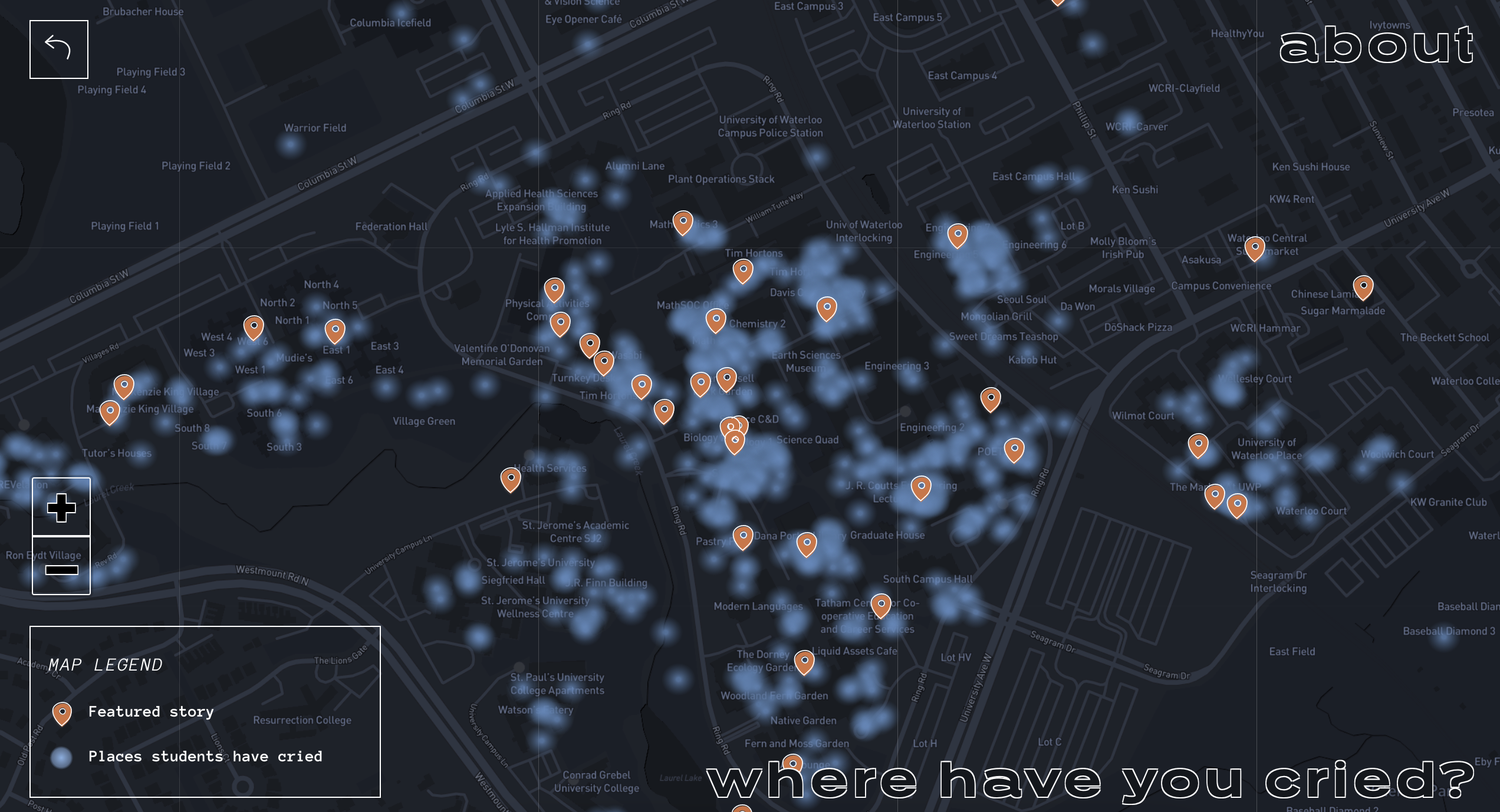It was the first semester that followed the initial COVID-19 lockdowns, one that made students feel deserted and left curriculums frozen in time.
Our isolation made bright admissions brochures feel ingenuine. We thought maybe, a colourful campus map could be more helpful if replaced with a guide on where everyone cried on campus.
There, began our campus Banksy fantasy.
Reddit always felt like the go-to spot for incognito emotional confessionals. Hacking our way through the Typeform free trial limits, we anonymously collected over 200 responses through a pseudonym.
Reading through campus' tears touched our hearts — people talked about a lot more than we had expected: incredibly heavy topics, and relatable moments, sprinkled with comedic relief.
The funny thing about loneliness and isolation, is that you rarely know that it's shared. Every story we read left an impression, and gifted us even more empathy for our peers.
What if we can give that feeling to others too?
Because COVID meant a lot of us no longer shared the same physical space, we wanted to create that sense of a shared emotional space using a map.
However, we knew our limited data isn't representative, so one risk with this geographic representation was peoples' natural gravitation towards pattern recognition. One might connect a high concentration of locations to the cause of specific programs, even if that wasn't the case.
But we still deeply believed in the power that maps have to illicit this empathy. Experiences that connect a digital experience to environmental surroundings can create deeper connections to the user (Pavliscak, 2018. pp.160)2.
This connection was espeically important for two reasons. One, to create a sense of belonging, which can help open up safer routes to discuss topics like mental health - something especially important for isolated students (Gopalan. 2021)1.
And two, to cultivate greater tolerance from people who may not have empathized with these teary stories at first. Divergent perspectives, espeically presented through high level patterns, can produce a profound cognitive shift in awareness that induces a sense of wonder. (Pavliscak, 2018. pp.188) 2.
Diving into the artifact, we had a little more fun than usual with the visual design of this site.
We wanted this tongue-in-cheek way to shine light on mental health at our college to feel playful. The homepage was then born with curved text in the shape of a face, sprinkled with some CSS animation for a falling tear.
We built the map with a similar visual language, using Leaflet and Mapbox, and built the site using React.
For the featured stories, we were the manual filters. We tried to choose the most representative stories, highlighting a variety of emotions, experiences, and backgrounds, and made sure to cover any potentially identifying information.
Lastly, We put together the Google Form to collect further submissions. Even though the stories didn't update live on the map, we wanted an avenue for emotional articulation, as this practice of recall can contribute to a better experience of processing emotions, and can even be theraputic (University of California, 2007)3.
With these parts all put together between pockets of free time over three weeks, we finally published it.

We posted it on Reddit through our pseudonym in an anticlimactic release, and conversed into the night reflecting on our experience before logging off. And to our surprise, by the next morning, eyes had flooded into our project — CBC even reached out to do an interview.
After debating the thickness of our Banksy mask, we ended up on CTV for a live interview, in an article for UWaterloo News, along with a few local and student publications. We saw 10K+ site visits that week, (and 3 overdue Mapbox bills, shhh).
The map elicited a number of public responses, both positive and negative. However, for the audience that mattered to us, the UWaterloo community, it landed the way we intended it to.
For students who have openly cried, or had to hold them in, it unlocked a sense of togetherness we'd forgotten since campus closed. The brief virality revealed its broader resonance.
During a time when the names of buildings on a campus map meant next to nothing, our collective tears and stories did.
Mental health on college campuses isn't something that can be solved by a website, but maybe opening that empathy and curiosty through storytelling, was a contribution.
*As of May 11th 2021, we updated the map with a handful more stories that we felt should be represented based on the overwhelming number of additional submissions, but since then, we have not been monitoring responses, and the project will be live but unmaintained.